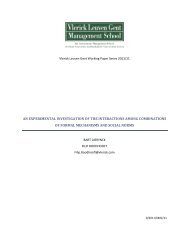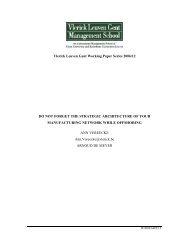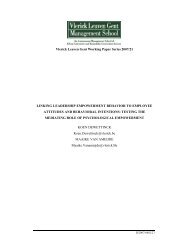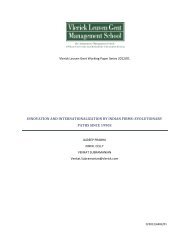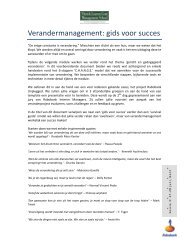Vlerick Leuven Gent Working Paper Series 2007/03 ... - Vlerick Public
Vlerick Leuven Gent Working Paper Series 2007/03 ... - Vlerick Public
Vlerick Leuven Gent Working Paper Series 2007/03 ... - Vlerick Public
You also want an ePaper? Increase the reach of your titles
YUMPU automatically turns print PDFs into web optimized ePapers that Google loves.
In particular, board members can be ask to rate statements such as “discussions during<br />
the meetings are constructive”, “when discussing an issue directors state clear disagreement<br />
with each other”, “different directors propose different approaches to the issue”, “directors<br />
openly challenge each other’s opinion” and “discussions of the issue become heated”.<br />
The effects of board characteristics on board processes<br />
Board size refers to the number of board members. It simply represents a board’s<br />
structural and compositional context. Hambrick & D’aveni (1992) state: “at a basic level, the<br />
resources available on a team result from how many people are on it” (p.1449). Board size is a<br />
well-researched characteristic as it is considered to have an important impact on the<br />
functioning of a board. Still, the effects produced by board size are not unambiguous as they<br />
can be both positive and negative. In many studies, board size is recognized as a proxy for<br />
directors’ expertise, and in this respect, board size is synonymous with cognitive capability<br />
(Amason and Sapienza, 1997). Larger boards have the potential to provide an increased pool<br />
of expertise because their members likely have a broader variety of backgrounds and may<br />
represent more specialized knowledge and skills (Smith et.al., 1994). For this reason, larger<br />
boards are better equipped (compared to small boards) to process large amount of information<br />
(Eisenhardt and Schoonhoven, 1990). The possibility for boards to draw on a larger pool of<br />
expertise likely contributes to the quality of the discussions in board meetings.<br />
Jensen (1993) however contends that board size is not unlimited. There exists a<br />
turning point where the benefits of an enlarged board will be outweighed by the costs in terms<br />
of productivity losses. As size increases, boards may be confronted with some traditional<br />
group dynamic problems associated with large groups. In fact, larger boards of directors<br />
become more difficult to co-ordinate and may experience problems with communication and<br />
organization, a proposition borrowed from organizational behaviourists (see for instance<br />
Hackman, 1990; Eisenberg et.al., 1998). By consequence, too large boards may be inhibited to<br />
have a fruitful debate. Besides, having a high number of board members around the table may<br />
hamper the board’s ability to identify, extract and use its members’ potential contribution.<br />
Given the limited time available during board meetings, there might be too many members to<br />
hear from and to persuade (Patton and Baker, 1987).<br />
Finally, larger boards - as any large group - may find it difficult to establish the<br />
interpersonal relationships which further cohesiveness (Shaw, 1976).<br />
16



